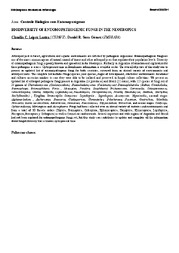Biodiversity of entomopathogenic fungi in the neotropics.
Biodiversity of entomopathogenic fungi in the neotropics.
Author(s): LÓPEZ LASTRA, C. C.; SOSA GÓMEZ, D. R.
Summary: Arthropod pest in forest, agricultural and aquatic environments are infected by pathogenic organisms. Entomopathogenic fungi are one of the most common agents of natural control of insect and other arthropod pests that regulates their population levels. Diversity of entomopathogenic fungi is poorly known and spread out in the Neotropics. Furtherly in Argentina information and exploration for these pathogens is scarce. Up present time in Brazil more information is available so far. The overall objective of this study was to present an updated list of entomopathogenic fungi for both countries, surveyed from an abroad variety of environments and arthropod hosts. The complete list includes fungal species, host species, stages of development, substrates/ environments/ locations/ and cultures accession number in case they were able to be isolated and preserved in fungal culture collections. We present an updated list of arthropod pathogenic fungi present in Argentina (14 provinces) and Brazil (22 states), with 125 species of fungi out of 34 genera of Chytridiomycetes (Coelomycidium), Blastocladiomycetes (Coelomomyces) Entomophthorales (Batkoa, Conidiobolus, Entomophaga, Entomophthora, Furia , Neozygites, Pandora, Zoophthora. Trichomycetes, Carrouxella, Coleopteromyces, Genistellospora, Glotzia, Harpella, Lege idiomyces, Passalomyces, Plecopteromyces, Penella, Simuliomyces, Smittium, Stachylina, Stachylinoides) ; Kingdom Stramenipila Oomycetes: Leptolegnia , Saprolegnia, Ascomycota: Hypocreales, asexual stages: (Aphanocladium , Aschersonia, Beauveria, Cladosporium, Clonostachys, Evlachovaea, Fusarium, Geotrichum, Gibellula, Hirsutella, Isaria Lecanicillium, Metarhizium, Nomuraea,, Paecilomyces, Tolypocladium, Tetracrium, and sexual stages Cordyceps, Ophiocordyceps, Myriangium and Ascosphaera. Fungi had been collected over an abroad variety of sustrates and environments and from a total of 10 Insecta orders (Diptera, Dermaptera, Coleoptera, Ephemeroptera, Hemiptera, Hymenoptera, Lepidoptera, Plecoptera, Psocoptera y Orthoptera) as well as from Acari and araneids. Several important and wide regions of Argentina and Brazil had not been explored for entomopathogenic fungi yet, but this study can contributes to update and compilate all the information about fungal diversity that is known up to present time.
Publication year: 2008
Types of publication: Book sections
Unit: Embrapa Soybean
Keywords: Entomology, Fungo Entomógeno, Patogenicidade
Observation
Some of Embrapa's publications are published as ePub files. To read them, use or download one of the following free software options to your computer or mobile device. Android: Google Play Books; IOS: iBooks; Windows and Linux: Calibre.
Access other publications
Access the Agricultural Research Database (BDPA) to consult Embrapa's full library collection and records.
Visit Embrapa Bookstore to purchase books and other publications sold by Embrapa.

